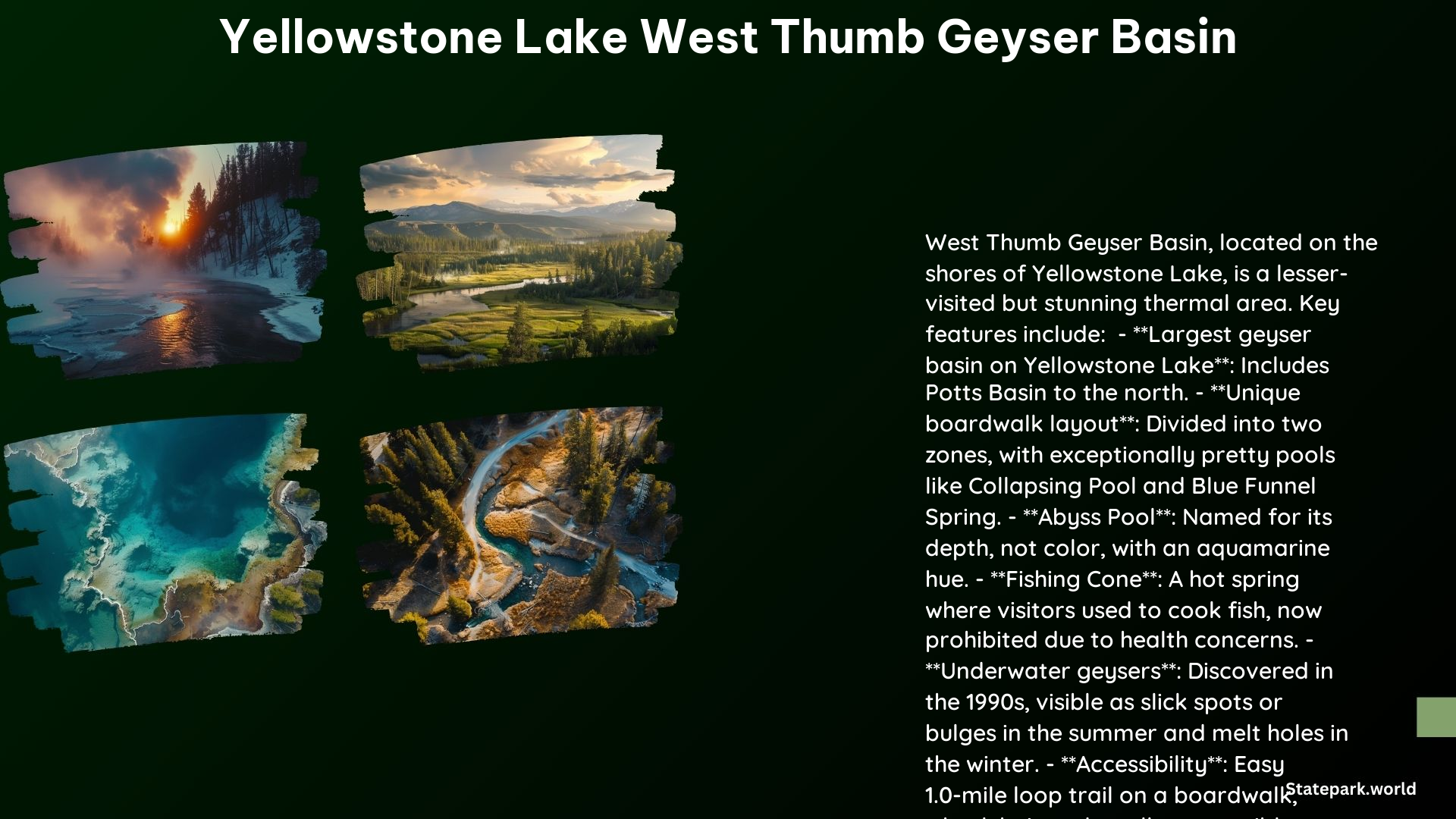The West Thumb Geyser Basin, nestled along the shores of Yellowstone Lake, is a captivating and lesser-known thermal area within the vast expanse of Yellowstone National Park. This unique geological wonder offers visitors a chance to witness the dynamic interplay between the park’s volcanic past and its present-day hydrothermal activity.
Historical Significance
The West Thumb Geyser Basin holds a significant place in the history of Yellowstone exploration and tourism. In 1827, Daniel T. Potts, a trapper, became the first person to document the area in a published letter, marking the beginning of its scientific and cultural recognition. The Folsom-Cook-Peterson Expedition, which visited the basin in 1869, further solidified its importance as a key destination for early scientific expeditions in Yellowstone.
As the park’s tourism industry began to flourish, the West Thumb Geyser Basin became a popular lunch spot and a hub for visitors arriving by stagecoach or steamship. The area’s unique features and proximity to Yellowstone Lake made it a must-see attraction for early park visitors.
Notable Features

The West Thumb Geyser Basin boasts a diverse array of hydrothermal features, each with its own captivating story and visual appeal.
Abyss Pool
Abyss Pool, named for its impressive depth, is a hot spring with a stunning aquamarine color. This feature was first described by Lieutenant G.C. Doane during the 1870 Washburn Expedition and later named by Chief Park Naturalist C.M. Bauer in 1935.
Black Pool
Historically, the Black Pool had a dark appearance due to the growth of brown cyanobacteria. However, a temperature shift in 1991 killed off the bacteria, leaving the pool with an intensely blue hue.
Fishing Cone
The Fishing Cone, a hot spring located near the shore of Yellowstone Lake, was once a popular spot for visitors to cook their freshly caught fish. This practice, now prohibited, was a unique and iconic part of the early days of Yellowstone tourism.
Underwater Geysers
In the 1990s, several underwater geysers were discovered in the West Thumb Geyser Basin. These features are visible as slick spots or bulges in the summer and melt holes in the winter ice, offering a glimpse into the dynamic nature of the park’s hydrothermal systems.
Visitor Information
The West Thumb Geyser Basin is easily accessible to visitors, with a boardwalk trail that is generally considered easy and wheelchair/stroller-friendly. The best time to visit is from May to October, with the trail taking an average of 21 minutes to complete.
In addition to the fascinating hydrothermal features, the area is known for its diverse wildlife, including sightings of elk, bald eagles, osprey, and other species that thrive in the unique ecosystem.
Geological Formation
The West Thumb of Yellowstone Lake was formed by a large volcanic explosion approximately 150,000 years ago, creating a caldera within a caldera. The heat source for the hydrothermal features in the basin is thought to be relatively close to the surface, around 10,000 feet down.
Exploring the West Thumb Geyser Basin offers visitors a chance to witness the dynamic interplay between Yellowstone’s volcanic past and its present-day hydrothermal activity. From the captivating Abyss Pool to the historic Fishing Cone, this lesser-known thermal area provides a unique and unforgettable experience within the vast and awe-inspiring Yellowstone National Park.
References:
1. https://yellowstoneinsider.com/exploring-west-thumb-geyser-basin/
2. https://www.nps.gov/yell/planyourvisit/westthumbgrantvillage.htm
3. https://www.alltrails.com/trail/us/wyoming/west-thumb-geyser-basin
4. https://www.nps.gov/yell/learn/nature/west-thumb-geyser-basin.htm
5. https://www.tripadvisor.com/Attraction_Review-g60999-d290467-Reviews-West_Thumb_Geyser_Basin-Yellowstone_National_Park_Wyoming.html
